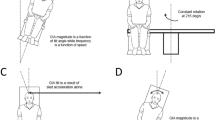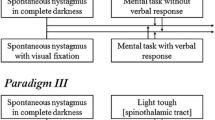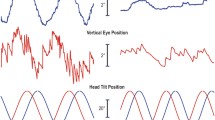Summary
Several studies in the past have demonstrated the existence of an Otolith-Ocular Reflex (OOR) in man, although much less sensitive than canal ocular reflex. The present paper 1 confirms these previous results. Nystagmic eye movements (L-nystagmus) appear in the seated subject during horizontal acceleration along the interaural axis in the dark for an acceleration level (1 m/s2) about ten times the perception threshold with a sensitivity of about 0.035 rad/m.
When sinusoidal linear acceleration is combined with optokinetic stimulation, the recorded nystagmus slow phase velocity exhibits strong periodic modulation related to subject motion. This marked effect of linear acceleration on the optokinetic nystagmus (OKN) appears at a level (0.1 m/s2) close to the acceleration perception threshold and has a 4-fold higher sensitivity than L-nystagmus. Modulation of OKN can reach a peak-to-peak amplitude as great as 20 °/s; for a given optokinetic field size it increases with the velocity of the optokinetic stimulus, i.e. with the slow phase eye velocity. In parallel with changes in OKN slow phase velocity, linear acceleration induces a motion related decrease in the perceived velocity of the visual scene and modifications in selfmotion perception.
The results are interpreted in terms of a mathematical model of visual-vestibular interaction. They show that sensory interaction processes can magnify the contribution given to the control of eye movements by the otolithic system and provide a way of exploring its function at low levels of acceleration.
Similar content being viewed by others
References
Baarsma EA, Collewijn H (1975) Eye movements due to linear acceleration in the rabbit. J Physiol (Lond) 245: 227–247
Babiiak VI (1978) Les composantes sensorielles du nystagmus optocinétique sous l'action des accélérations angulaires. Kosm Biol Aviakosmicheskaya Med 1: 66–71
Baker R, Precht W, Berthoz A (1973) Synaptic connections to trochlear motoneurons determined by individual vestibular nerve branch stimulation in the cat. Brain Res 64: 402–406
Barnes GR, Benson AG, Prior ARJ (1978) Visual vestibular interaction in the control of eye movement. Aviat Space Environ Med 49: 557–564
Benson AJ, Bodin MA (1966) Interaction of linear and angular acceleration on vestibular receptors in man. Aerosp Med 37: 144–154
Berthoz A, Pavard B, Young LR (1975) Perception of linear horizontal self motion induced by peripheral vision (linear vection). Basic characteristics and visual vestibular interactions. Exp Brain Res 23: 471–489
Berthoz A, Buizza A, Schmid R (1977) Visual vestibular interaction during linear motion. ESA SP- 130: 117–125
Buizza A, Schmid R, Zanibelli A., Mira E, Semplici P (1978) Quantification of vestibular nystagmus by an interactive computer program. ORL 40: 147–159
Buizza A, Léger A, Berthoz A, Schmid R (1979) Otolithicacoustic interaction in the control of eye movement. Exp Brain Res 36: 509–522
Carpenter MB (1960) Fiber projections from descending and lateral vestibular nuclei in the cat. Am J Anat 107: 1–22
Cohen B, Highstein SM (1972) Cerebellar control of the vestibular pathways to oculomotor neurons. In: Brodai A, Pompeiano O (eds) Basic aspects of central vestibular mechanisms. Amsterdam, Elsevier (Progress of brain research, vol 37, pp 411–428)
Crampton GH (1966) Does linear acceleration modify cupular deflection?, II Symp. on the Role of Vestibular Organs in Space Exploration. NASA SP-115: 169–184
Dichgans J (1977) Optokinetic nystagmus as dependent on the retinal periphery via the vestibular nucleus. In: Baker R, Berthoz A (eds) Control of gaze by brain stem neurons. Amsterdam, Elsevier North-Holland, pp 261–267
Dichgans J, Brandt T (1978) Visual vestibular interaction: Effects on self-motion perception and in postural control. In: Held R, Leibowitz H, Teuber HL (eds) Perception. Springer, Berlin Heidelberg New York (Handbook of sensory physiology, vol 8, pp 755–804)
Fernandez C, Goldberg JM (1976) Physiology of peripheral neurons innervating otolith organs in the squirrel monkey. III. Response dynamics. J Neurophysiol 39: 970–1008
Fluur E (1960) Vestibular compensation after labyrinthine destruction. Acta Otolaryngol (Stockh) 52: 367–375
Fluur E (1970) Utricular stimulation and oculomotor reactions. Laryngoscope 70: 413–431
Galoian VP, Zenkin GM (1976) Etude des mouvements de torsion de l'œil. Biofizika 21: 570–577
Graybiel A, Patterson JL (1955) Thresholds of stimulation of the oblith organs as indicated by the oculagravic illusion. J Appl Physiol 7: 666–670
Graybiel A (1974) Measurement of otolith function in man. In: Kornhuber HH (ed) Task. Springer, Berlin Heidelberg New York (Handbook of sensory physiology, vol 4/2, pp 233–266)
Grüsser OJ, Grüsser-Cornells U (1972) Interaction of vestibular and visual inputs in the visual system. In: Brodal A, Pompeiano O (eds) Basic aspects of central vestibular mechanisms. Elsevier, Amsterdam, pp 573–583
Guedry F (1974) Psychophysics of vestibular sensation. In: Kornhuber HH (ed) Vestibular systems. Springer, Berlin Heidelberg New York (Handbook of sensory physiology, vol 6, pp 3–154)
Guedry FE Jr, Lentz JM, Jell RM (1978) Visual vestibular interaction: influence of peripheral vision on suppression of the vestibular ocular reflex and visual acuity. WASA, NAMRL 1246
Gundry MJ (1978) Threshold of perception for periodic linear motion. Aviat Space Environ Med 49: 679–686
Helmholtz H von (1896) Handbuch der physiologischen Optik. Voss, Hamburg Leipzig
Hunte M (1786) The use of the oblique muscle. In: Nicol G, Johnson J (eds) Observations on certain parts of the animal oeconomy. London, pp 209–212
Jongkees LBW, Philipszoon AT (1962) Nystagmus provoked by linear accelerations. Acta Physiol Pharmacol Neerl 10: 238–247
Jung R (1977) Introduction: an appreciation of early work on gaze control in man and of visuo-vestibular research before 1940. In: Baker R, Berthoz A (eds) Control of gaze by brain stem neurons. Elsevier, Amsterdam, pp 1–10
Koenig E, Allum JHJ, Dichgans J (1978) Visual vestibular interaction upon nystagmus slow phase velocity in man. Acta Otolaryngol 85: 397–410
Léger A, Buizza A, Berthoz A, Schmid R (1978) Otolith contribution to ocular pursuit of acoustic targets. Exp Brain Res 32: R 25
Lestienne F, Soechting J, Berthoz A (1977) Postural readjustments induced by linear motion of visual scenes. Exp Brain Res 28: 363–384
Levison WH, Zacharias GL (1978) Motion cue models for pilot vehicle analysis. Aerospace Med Res Lab TR-78-2
Mach E (1875) Grundlinien der Lehre von den Bewegungsempfindungen. Engelmann, Leipzig
Masse, D (1976) Le contrôle des mouvements oculaires. Thèse, Université de Grenoble
Meiry JL (1966) The vestibular system and human dynamic space orientation. NASA CR-628
Niven SI, Hixson CE, Correia MJ (1965) Elicitation of horizontal nystagmus by periodical acceleration. Acta Otolaryngol 62: 429–441
Ormsby CC (1974) Model of human dynamic orientation. Ph. D. Thesis. MIT, Cambridge
Ormsby CC, Young LR (1976) Perception of static orientation in a constant gravito inertial environment. Aviat Space Environ Med 47: 159–164
Pavard B, Berthoz A (1977) Linear acceleration modifies the perceived velocity of a moving visual scene. Perception 6: 529–540
Pompeiano O, Walberg F (1957) Descending connections to the vestibular nuclei on experimental study in the cat. J Comp Neurol 108: 465–503
Precht W (1977) The functional synaptology of brain stem oculomotor pathways. In: Baker R, Berthoz A (eds) Control of gaze by brain stem neurons. Elsevier, Amsterdam, pp 131–142
Precht W, Llinás R (1969) Functional organization of the vestibular afferents to the cerebellar cortex of the cerebellar cortex of frog and cat. Exp Brain Res 9: 30–52
Precht W, Volkind R, Maeda M, Giretti ML (1976) The effects of stimulating the cerebellar nodulus in the cat on the vestibular neurons. Neuroscience 1: 301–312
Raphan T, Cohen B, Matsuo V (1977) A velocity storage mechanism responsible for optokinetic nystagmus (OKN) optokinetic after nystagmus (OKAN) and vestibular nystagmus In: Baker R, Berthoz A (eds) Control of gaze brain stem neurons. Elsevier, Amsterdam, pp 37–48
Robinson DA (1977a) Linear addition of optokinetic and vestibular signals in the vestibular nucleus. Exp Brain Res 30: 447–450
Robinson DA (1977b) Vestibular and optokinetic symbiosis: an example of explaining by modelling. In: Baker R, Berthoz A (eds) Control of gaze by brain stem neurons. Elsevier, Amsterdam, pp 49–58
Schmid R, Zambarbieri D, Sardi R (1979) A mathematical model of the optokinetic reflex. Biol Cybern 34: 215–225
Schmid R, Buizza A, Zambarbieri D (1979) A non-linear model for visual-vestibular interaction during body rotation in man. Biol Cybern (in press)
Schwindt PC, Richter A, Precht W (1973) Short latency utricular and canal input to ipsilateral abducens motoneurons. Brain Res 60: 259–262
Shillinger GL, Baumgarten RJ von, Baldrighi G (1973) The gravity reference response, the rotation sensation and other illusory sensations experienced in air craft and space flight. Space Life Sci 4: 368–390
Stark L (1971) The control system for versional eye movements. In: Bach-Y-Rita P, Collins CC, Hyde JE (eds) The control of eye movements. New York, Academic Press, pp 363–428
Steer R W (1967) The influence of angular and linear acceleration and thermal stimulation on the human semi-circular canal. Sc. D. Thesis. MIT, Cambridge
Suzuki JI (1972) Vestibulooculomotor relations: static responses. In: Brodal A, Pompeiano O (eds) Basic aspects of central vestibular mechanism. Elsevier, Amsterdam (Progress of brain research, vol 37, pp 507–514)
Szentágothai J (1964) Pathways and synaptic articulation patterns connecting vestibular receptors and oculomotor nuclei. In: Bender MB (ed) The oculomotor system. Harper and Row, New York, p 556
Ter Braak JWG (1936) Untersuchungen über optokinetischen Nystagmus. Arch Neurol Physiol 21: 309–376
Ter Braak JWG (1937) Kann der Bewegungsapparat durch geradlinige Beschleunigung gereizt werden? Pflügers Arch 238: 327–332
Timm C (1953) Physikalische Vorgänge bei der Labyrinthreizung. Z Laryngol Rhinol 32: 237–251
Tokunaga O (1977) The influence of linear acceleration on optokinetic nystagmus in human subjects. Acta Otolaryngol (Stockh) 84: 338–343
Vidic TR, Barlow JS, Oman CM, Tole JR, Weiss AD, Young LR (1976) Human eye tracking during vertical and horizontal motion. Neurosci Abstr 2: 1026
Woellner RC, Graybiel A (1959) Counterrolling of the eyes and its dependence on the magnitude of gravitational or inertial force acting laterally on the body. J Appl Physiol 14: 632
Yasui S (1973) Nystagmus generation, oculomotor tracking and visual motion perception. Ph. D. Thesis, Department of Aeronautics and Astronautics. MIT, Cambridge
Young LR, Meiry JL (1967) A revised dynamic otolith model. NASA SP 152: 363–368
Young L, Dichgans J, Murphy R, Brandt Th (1973) Interaction of optokinetic and vestibular stimuli in motion perception. Acta Otolaryngol (Stockh) 76: 24–31
Zacharias GL (1977) Motion sensation dependence on visual and vestibular cues. Ph. D. Thesis. MIT, Cambridge
Author information
Authors and Affiliations
Rights and permissions
About this article
Cite this article
Buizza, A., Léger, A., Droulez, J. et al. Influence of otolithic stimulation by horizontal linear acceleration on optokinetic nystagmus and visual motion perception. Exp Brain Res 39, 165–176 (1980). https://doi.org/10.1007/BF00237547
Received:
Issue Date:
DOI: https://doi.org/10.1007/BF00237547




